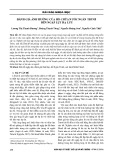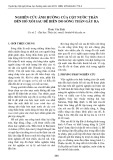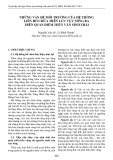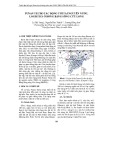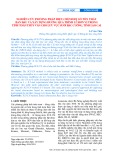
50 Le Thang VUONG, Hoai Chinh TRUONG, Trong Hieu TRAN
EVALUATION OF FACTORS AFFECTING THE COMPRESSIVE STRENGTH OF
GEOPOLYMER CONCRETE USING SEA SAND AND SEAWATER
Le Thang VUONG, Hoai Chinh TRUONG*, Trong Hieu TRAN
The University of Danang - University of Science and Technology, Vietnam
*Corresponding author: thchinh@dut.udn.vn
(Received: September 15, 2024; Revised: October 02, 2024; Accepted: October 15, 2024)
DOI: 10.31130/ud-jst.2024.520E
Abstract - This study comprehensively analyzes the impact of
temperature and curing time on the compressive strength of
geopolymer concrete made with locally sourced sea sand and
seawater. The research aims to utilize abundant regional materials
while reducing the environmental footprint associated with
traditional construction practices. By conducting systematic
experiments at elevated temperatures of 90°C and 120°C over
varying durations, the study evaluates the critical factors
influencing the mechanical performance of geopolymer concrete.
The results reveal that optimizing curing temperature and time
significantly enhances the compressive strength and durability of
the material. This breakthrough presents promising opportunities
for its broader application in eco-friendly and sustainable
construction, particularly in coastal and marine environments.
Key words - Sea sand; seawater; geopolymer concrete;
temperature; curing time; compressive strength.
1. Introduction
Geopolymer concrete has gained considerable attention
from scientists and engineers worldwide due to its potential
for significantly reducing CO2 emissions when compared
to traditional Portland cement-based concrete [1-6].
International research efforts have largely focused on the
development and optimization of geopolymer concrete
formulations, utilizing abundant materials such as fly ash,
blast furnace slag, and natural sands. Among the most
influential factors in enhancing the compressive strength
and mechanical properties of geopolymer concrete are
curing temperature and duration [7-11].
High curing temperatures have been shown to improve
the bonding between the components of the geopolymer
matrix, leading to increased compressive strength [8, 11].
Curing time is also critical, with durations of 3 to 28 days
commonly used to track strength development in
geopolymer concrete [7, 9, 10]. Additionally, multiple
studies have demonstrated the feasibility of using locally
sourced sand and seawater to produce geopolymer
concrete, creating a sustainable construction material well-
suited for marine environments [12-14]. For instance,
Adam's research confirmed that maximum compressive
strength was achieved at a curing temperature of 120°C and
a curing time of 20 hours for the specific materials used in
geopolymer concrete production [15].
In Vietnam, research on geopolymer concrete is still
relatively new, but significant progress has been made in
recent years. Domestic studies have mainly focused on the
application of fly ash and ground granulated blast-furnace
slag, two common industrial by-products, in the production
of geopolymer concrete [16-19]. Several universities and
research institutes, such as Hanoi University of Civil
Engineering and the Institute of Construction Science and
Technology, have conducted experiments on the factors
influencing the strength and durability of geopolymer
concrete. However, research on the use of sand and seawater
in geopolymer concrete production remains limited.
Local studies have emphasized the importance of
utilizing available resources to reduce costs and
environmental impact. However, the potential of using
seawater and sand from coastal areas, such as Ha Tien in
Kien Giang Province, has not been widely explored (Figure
1). These coastal regions offer significant opportunities for
the development of geopolymer concrete adapted to local
environmental and climatic conditions, which could reduce
reliance on traditional materials like river sand, a resource
that is becoming increasingly scarce.
Figure 1. Mui Nai Beach in Ha Tien City, Kien Giang Province
This study aims to evaluate the impact of curing
temperature and duration on the compressive strength of
geopolymer concrete made from sea sand and seawater
sourced from Mui Nai Beach, Ha Tien City, Kien Giang
Province. The abundant resources in this area make it an
ideal location for experimental research. Additionally, the
study includes a comparative analysis with control samples
made using freshwater and regular sand to provide more
objective results. The selected curing temperatures were
90°C and 120°C, with curing durations of 3, 7, 14, and 28
days, to not only assess the mechanical properties of the
material but also determine optimal curing conditions that
could enhance the performance and quality of geopolymer
concrete for practical construction applications.
2. Methodology
2.1. Research Content
2.1.1. Material Preparation
Marine sand and seawater were collected from Mui Nai







